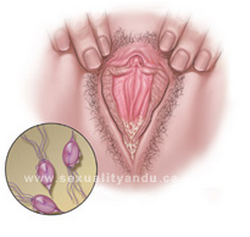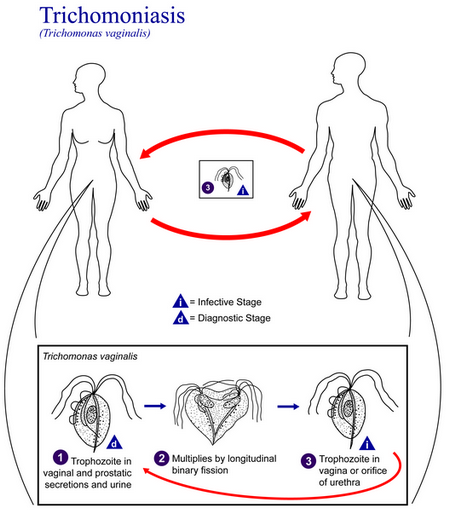What is Trichomoniasis?
Trichomoniasis (commonly referred as “Trich”) is a sexually transmitted disease (STD) caused by the parasite, Trichomonas vaginalis. The parasite settles at the urogenital tract and infects sexually active individuals. This will happen with multiple partners or with those who do not use any form of protection. This is the most frequent but curable STD in sexually active young women. Most patients who were diagnosed with gonorrhea and non-gonococcal urethritis were also found to be infected with this disease.
The protozoan parasite that causes trich survives in the dark moist regions of the body making the female anatomy a suitable host. Moreover, Trichomonas can manage to survive outside the host for many hours. This increases the risk of transmission even without sexual contact – a humid and alkaline environment can contribute to this. It can be sometimes transferred by groin contact with any moist surfaces. However, for transfer to effectively occur there must be a direct contact of the genital surfaces to the infected area. There are rare incidents where sharing of wet towels or bathing suits caused the transmission of these microscopic parasites. Trichomoniasis in men also occurs but they are often just carriers, with no perceptible symptoms.
Trichomonas Infection
Most of the infected individuals have no symptoms. That makes it more difficult to control the transmission of the disease. It estimated that around 7.4 million new cases worldwide occur every year, affecting both men and women. In the United States, based on the Center for Disease Control (CDC) reports, about 2 million Americans are infected every year.[1] UK reports roughly 600,000 cases each year. [3] Trich been found in 5 to 15% of women in gynecology clinics and approximately 50 to 75% in prostitutes around United States. [1]
Menstruation causes women to be more susceptible to Trichomonas infection in the vagina. Signs and symptoms usually appear after 1-3 weeks after transfer. But during that time, the parasites can already be transferred to someone else before symptoms appear. [2]|Trichomoniasis in men is seemingly the cause of 7- 10% of urethritis, although identification of the parasite is quite difficult.
Genital skin, particularly the squamous epithelium, is the primary target of T. vaginalis. Incubation period is normally 4 to 28 days but the infection process would take longer in women than in men (10 days or less). Some studies have shown that some women may have infections without symptoms for months or years. The infection only produces partial immunity.
Since the history and physical findings are not reliable to correctly diagnose the presence of trichomoniasis, laboratory exams are very important. The problem with this is that the lab tests for this disease are not available in most hospitals and clinics. Surveys have shown that only six of the 100 Public Health laboratories perform the tests for trichomoniasis . Not only that, but those who did perform them do not have the latest methods for detection.
Trichomoniasis Symptoms
Symptoms of trichomoniasis are often not visible. An individual who has sexual contact with a partner infected with the disease may manifest the symptoms even just 5 days after the contact. There have been reported rare cases of a 20-year incubation period. Symptomatic Trichomonas infection is more prevalent in women than in men. Trichomoniasis in men is less clinically evident.
Symptoms of Trichomoniasis in Women
The most significant symptoms of trichomoniasis among women are vaginal itching (mild to severe) with profuse yellowish green vaginal discharges. Other symptoms include:
- Pain or burning sensation in the vagina
- Strong “fishy” smell
- Epigastric pain
- Painful sexual intercourse
- Inflammation in the groin, vagina or cervix
- Excessive urination
- Painful urination
- Painful menstruation
- Colpitis macularis (strawberry cervix) is the definite sign for trichomoniasis. It is dispersed or irregular macular erythematous cervical lesions
Trichomoniasis Symptoms in Men
Symptoms of trichomoniasis in men may range from urethritis to none. If symptoms do manifest, they will include:
- Painful urination
- Inflammation of the glans penis
- Inflammation of glans penis, prepuce and foreskin
- Tingling sensation in penis
- Painful ejaculation
- Prostatis
- Excessive urination
The most frequent symptom described by men with Trichomonas infection is non-gonococcal non-chlamydial urethritis that appears as pruritis at the urethral area, penile discharges and dysuria. Penile discharges may range from mucoid to purulent. Most of these symptoms are self-limiting and intermittent but may cause complications such as epididymitis, prostatitis, infertility and urethral strictures.
Trichomoniasis Pictures
Picture 1 : Trichomonas vaginalis (Trophozoite)
Picture 3 : Trichomoniasis
STD Trichomoniasis
Sexually transmitted diseases are those infections transferred by sexual contact from the host to another. Based on CDC reports, there are more than 15 million STD cases reported in the U.S. each year. Among these diseases, trichomoniasis is one of the most common type. Individuals from different age brackets are affected. Among the 19 million infections reported each year, most are between ages 15 and 24.
Trichomoniasis is greatly associated with the existence of other STDs such as gonorrhea and Chlamydia. The presence of Trichomoniasis increases the individual’s susceptibility to HIV, herpes and human papillomavirus. The irritation of the epithelial layer weakens the passageway for the HIV to penetrate. Then the parasite, T. vaginalis, activates the cytokine and T-lymphocytes which then replicate. That increases the replication of the cells infected with HIV. It also increases the chances of the development of pelvic inflammatory disease and tubal infertility.
Infected women have increased probability of delivering preterm infants. Or they may develop adverse complications in pregnancy such as:
- premature rupture of the membranes,
- intrauterine infection and
- decreased infant birth weights.
Although trichomoniasis is not a very serious disease, it is very contagious. If left untreated, it can cause infection not only in the urinary tract but also throughout the reproductive system.
Trichomoniasis Treatment
Symptoms experienced by men infected with trichomoniasis are self-limiting. They generally clear up over a period of time. Yet, these men are still considered carriers. That means they are still capable of transmitting the trich organisms to their sex partners.
Women, on the other hand, need to undergo treatment for trichomoniasis. It is advisable for both partners to be treated concurrently in order to prevent re-infection. Sexual activities have to be put on hold until treatment plan has been completed.
Treatment for trichomoniasis is usually metronidazole, a nitro-imidazole antibiotic for protozoa and anaerobic bacteria. The standard dose is 400 mg BID for five to seven days. An alternative dosage is to use 2 grams in single dose. The single dose alternative is less effective and may cause additional side effects. Take the medication with food to prevent irritation of the gastrointestinal tract.
Pregnant women are usually not given this medication treatment for trichomoniasis. Studies have shown an increased risk of birth defects because the medicine. Also, there are increasing cases of metronidazole-resistant T. vaginalis . This has prompted the search for other medications to treat the disease.
Tinidazole is the second drug of choice and is taken as single dose (2 g) only. This drug is normally given to patients who do not respond to the metronidazole therapy. It has a cure rate of 83-100%. Clotrimazole vaginal suppositories were sometimes used to treat the disease but an early study made by duBouchet showed a low cure rate (11%). When medication is given as an external treatment it is not very effective at all. [8]
Prevention of Trichomoniasis
Preventive measures should also be started to avoid being infected again. Abstaining from sex is the best preventive measure. Maintain a monogamous relationship where both partners are not infected. [6] Protected sex is advised for sexually active individuals. Though it is not fool-proof, using a condom and practicing safe sex can offer some protection.
References:
- http://www.cdc.gov/std/trichomonas/stdfact-trichomoniasis.htm
- http://www.medicinenet.com/trichomoniasis/article.htm
- http://www.essortment.com/trichomoniasis-39280.html
- http://www.ncbi.nlm.nih.gov/books/NBK7889/
- http://www.pamf.org/teen/sex/std/std/trichomonas.html
- http://my.clevelandclinic.org/disorders/Trichomoniasis/hic_Trichomoniasis.aspx




I took my medication for trich but still have bit discharge… do i have to go back and see whats wrong..?